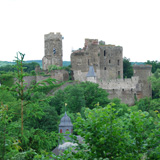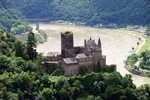History
Burg Reichenberg, a hilltop castle built around 1319 by Count Wilhelm von Katzenelnbogen on Mount Richenberch, is a significant example of medieval architecture. At the time of Wilhelm's death in 1331, only the shield wall with two 40-meter-high flanking towers, the eastern outer bailey, and the foundations of the western main castle were completed. Wilhelm II reversed the original plans and built his castle on the grounds of the outer bailey.

By 1358, the residential building was completed with casemates facing east and south. It is the oldest residential building in Germany. The building includes column constructions like those found in Syrian Crusader castles. In 1371, Count Wilhelm II donated an altar with an eternal mass in his chapel at Burg Reichenberg for the salvation of his own soul and that of his wife Else, his brother Eberhard, and relatives.
In 1385, the construction of an expansion to the outer bailey and farm castle, barns, and cellars was completed. 1385 also saw the death of Count Wilhelm II von Katzenelnbogen, and his brother Eberhard V von Katzenelnbogen inherited the castle.
In 1479, Philip the Elder, the last Count of Katzenelnbogen, died at the age of 77 without a male descendant. Burg Reichenberg passed to Heinrich von Hesse by inheritance. In 1567, was inherited by Phillip II as Landgrave of Hesse-Rheinfels, who died childless in 1583.
During the Thirty Years' War (1618-1648), Burg Reichenberg was used as a refuge by the people of Reichenberg and the surrounding villages.
In 1647, the Landgravin Amalie von Hesse-Kassel decided to take back the lost Lower County of Katzenelnbogen for Hesse-Kassel by force of arms. They took the Dutch General Kasper Cornelius Mortaigne of Portalis into their service. During their successful campaign to conquer their former lands, General Montaigne appeared in front of Burg Reichenberg in June 1647. He set up camp and besieged the castle. The castle was taken after a long bombardment and undermining of the ring wall.
In 1649, the castle passed to Ernst I of Hesse-Rhienfels-Rothenburg, who repaired the damage from the previous siege. The restoration work took place between 1649 and 1651. The castle lost its military value after the Thirty Years' War and became the administration seat of the Amt of Reichenberg, resulting in the construction of grain warehouses and barns.
It remained a Hessian fortress until 1806. In 1813, the upper third of the south tower of the shield wall collapsed. To avert further danger of collapse, the remaining tower was blown up.
In 1821, it was sold to Moses Aron for demolition, who sold all usable parts apart from the castle walls themselves. However, the demolition was never carried out as the castle was acquired by Friedrich Gustav Habel in 1836, who made a large contribution to its preservation. In 1880, Baron Wolfgang von Oettingen built a residential building and did much to secure the castle. The von Oettingen family owned the castle until 1956.
In 1945, during the last days of the Second World War, the castle received several hits from American artillery from the left bank of the River Rhine, causing some corbels on the north tower to break off.
In April 1971, the north tower of the shield wall collapsed and slid down to the rock base. The rubble spread over the castle bailey and rose garden on the north side.
Since 2010, Burg Reichenberg's new owner, together with the General Directorate of Cultural Heritage Rhineland-Palatinate, has been working to save the castle from further decay.
Castle Highlights
The castle is privately owned and can be viewed from the exterior only. It has a two-story casemated terrace on the east side. The main castle consists of a shield wall that used to be adorned by flanking 40-meter-high towers, which have now collapsed with the passage of time.
A pentagonal ring wall surrounds the castle bailey. In front of the north ring wall rises the residential buildings. The bailey includes other structures along the southeast wall, such as the kitchen, cellars, and household rooms.
There are many nearby castles on the River Rhine that are open for visiting, including Marksburg, Burg Rheinfels, and Burg Sooneck.




